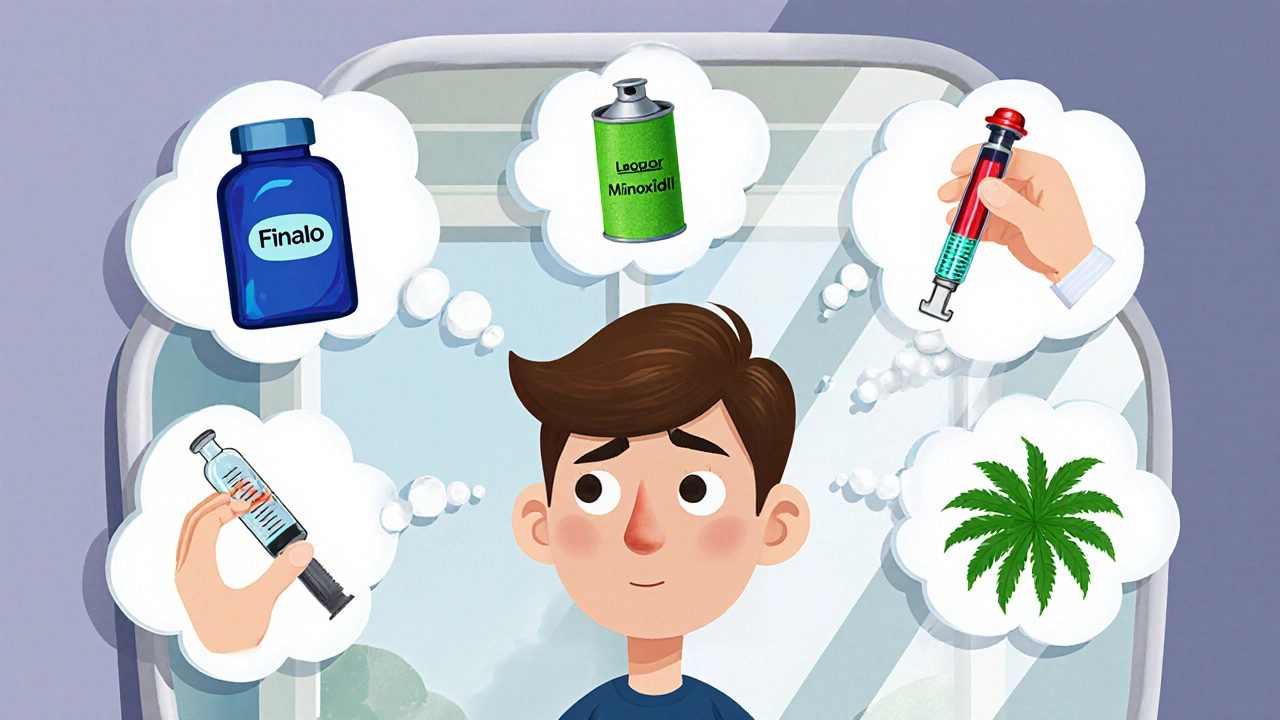 Oct, 15 2025
Oct, 15 2025
Hair Loss Treatment Cost Calculator
Compare the annual costs of different hair loss treatments to find the best budget fit for your needs. Select one or more treatments to calculate your total annual cost.
Select treatments to see your total annual cost.
When you’re fighting male‑pattern baldness, the market is flooded with pills, lotions, devices and even surgeries. Picking the right option feels like a gamble-will you see a thicker crown or waste money on a dud? This guide puts Finasteride (branded as Finalo) side‑by‑side with the most common alternatives so you can decide what fits your budget, lifestyle and risk tolerance.
What is Finalo (Finasteride) and How Does It Work?
Finalo is a prescription medication whose active ingredient is Finasteride, a 5‑alpha‑reductase inhibitor that blocks the conversion of testosterone to dihydrotestosterone (DHT). DHT shrinks hair follicles on the scalp, leading to thinning and eventual loss. By lowering scalp DHT levels, Finasteride can halt that process and even regrow hair in many men. The typical daily dose is 1mg, taken orally. Clinical trials show about 65% of users experience a noticeable reduction in hair shedding, while roughly 30% see measurable regrowth after three to six months.
Alternative Hair‑Loss Options Worth Considering
Below are the most popular alternatives, each with a brief snapshot of how it tackles baldness.
- Dutasteride is another 5‑alpha‑reductase inhibitor, but it blocks both TypeI and TypeII enzymes, making it roughly twice as potent as Finasteride. Commonly prescribed off‑label for hair loss, the standard dose is 0.5mg daily.
- Minoxidil is a topical solution or foam applied twice a day. Originally a blood‑pressure drug, it widens blood vessels around hair follicles, boosting oxygen and nutrient delivery. Over‑the‑counter concentrations are 2% for women and 5% for men.
- Low‑Level Laser Therapy (LLLT) uses red light (630‑660nm) delivered via a headset, comb or cap. The photons stimulate cellular metabolism in follicular stem cells, encouraging growth cycles.
- Platelet‑Rich Plasma (PRP) involves drawing a small amount of the patient’s blood, concentrating platelets, then injecting the plasma into the scalp. Growth factors released from platelets can revitalize dormant follicles.
- Hair Transplant Surgery (FUE or FUT) moves healthy follicles from a donor area (usually the back of the head) to balding zones. It offers a permanent, natural‑looking solution but requires a skilled surgeon and a hefty out‑of‑pocket cost.
- Saw Palmetto is a plant extract marketed as a natural DHT blocker. Typical oral doses range from 160mg to 320mg per day. Evidence is mixed, but many men use it as a low‑risk adjunct.
- Ketoconazole Shampoo contains an antifungal agent that also reduces scalp DHT when used regularly (2-3 times a week). It’s often paired with other treatments for a synergistic effect.
Side‑Effect Profile: What to Watch For
Every option carries some risk. Here’s a quick rundown:
- Finasteride (Finalo): sexual dysfunction (decreased libido, erectile issues) in 2‑4% of users, rare mood changes, and a small chance of breast tenderness.
- Dutasteride: similar sexual side effects, but higher incidence of decreased semen volume; also can affect liver enzymes.
- Minoxidil: scalp irritation, itching, and occasional unwanted facial hair growth.
- LLLT: generally safe; occasional eye strain if the device is too close.
- PRP: mild pain at injection sites, temporary swelling, rare infection.
- Hair Transplant: post‑operative pain, risk of scarring or graft failure.
- Saw Palmetto: gastrointestinal upset, rarely dizziness.
- Ketoconazole Shampoo: dry scalp or mild burning sensation.

Cost Overview: From Pocket‑Friendly to Premium
Price is a decisive factor for many. Below is a rough annual cost range for each approach (U.S. pricing, 2025).
| Treatment | Typical Dose/Session | Effectiveness (% hair regrowth) | Common Side Effects | Annual Cost (USD) |
|---|---|---|---|---|
| Finalo (Finasteride) | 1mg oral daily | 30‑65% | Sexual dysfunction, mood changes | $150‑$300 (generic) |
| Dutasteride | 0.5mg oral daily | 40‑70% | Sexual issues, liver enzyme changes | $250‑$450 (generic) |
| Minoxidil | 5% foam twice daily | 15‑25% | Scalp irritation, unwanted hair | $120‑$200 |
| LLLT Device | 15min 3‑times/week | 10‑20% | Eye strain (rare) | $600‑$1500 (one‑time) |
| PRP Therapy | 3‑4 sessions/year | 20‑40% | Pain, swelling | $800‑$2000 |
| Hair Transplant | 1‑2 sessions | 90‑100% (permanent) | Pain, scarring | $4000‑$15000 |
| Saw Palmetto | 160‑320mg oral daily | 5‑15% | GI upset | $60‑$120 |
| Ketoconazole Shampoo | 2‑3×/week | 5‑10% | Dry scalp | $30‑$80 |
How to Choose the Right Option for You
There’s no one‑size‑fits‑all answer. Consider these decision points:
- Severity of loss. Early‑stage thinning often responds well to medication (Finasteride, Minoxidil) or low‑cost topical agents. Advanced recession may need surgery or PRP.
- Risk tolerance. If sexual side effects scare you, a non‑systemic route like Minoxidil, LLLT or topical ketoconazole might be safer.
- Budget. Generic Finasteride is the cheapest proven prescription; hair transplant is the most expensive but offers permanent results.
- Time commitment. Daily pills or foams require discipline. Devices (LLLT) need regular sessions. Surgery is a one‑time event with recovery time.
- Medical history. Men with liver disease should avoid Dutasteride; those with prostate issues often already take Finasteride.
Many users combine treatments for a synergistic boost-e.g., Finasteride plus Minoxidil plus Ketoconazole shampoo. The combo targets DHT production, follicle stimulation, and scalp health all at once.

Quick Takeaways
- Finasteride (Finalo) is the most evidence‑backed oral option, delivering 30‑65% regrowth at a modest cost.
- Dutasteride is a stronger DHT blocker but carries a slightly higher side‑effect load.
- Topical Minoxidil is inexpensive and safe, though its results are modest.
- Device‑based LLLT and injections (PRP) sit in the mid‑range of price and effectiveness.
- Hair transplant remains the only permanent, high‑yield solution but requires a surgeon and significant investment.
Next Steps & Troubleshooting
If you decide on Finasteride, start with a 1mg tablet daily and give it at least three months before judging results. Track shedding with a simple weekly photo log. Should you notice persistent sexual side effects, discuss dose reduction or a switch to Dutasteride with your dermatologist.
For device users, ensure the LLLT unit meets FDA clearance and follow the manufacturer’s recommended session length. Missed sessions cost you; consistency is key.
Considering surgery? Schedule a consultation with a board‑certified hair restoration surgeon, ask for before‑and‑after photos, and verify the clinic’s infection‑control protocols.
Frequently Asked Questions
Can I use Finalo and Minoxidil together?
Yes. Combining an oral DHT blocker like Finasteride with topical Minoxidil is a common strategy. The two work through different mechanisms, so they often boost each other’s results without adding significant side effects.
Is Finasteride safe for women?
Finasteride is not approved for use in women, especially those of child‑bearing age, because it can cause birth defects. Post‑menopausal women sometimes use it off‑label under strict medical supervision, but it’s rarely recommended.
How long does it take to see results with Finalo?
Most men notice a reduction in shedding within 3months and measurable regrowth after 6‑12months. Patience is crucial; stopping the drug will likely reverse any gains.
What are the main advantages of Dutasteride over Finasteride?
Dutasteride blocks both TypeI and TypeII 5‑alpha‑reductase enzymes, cutting DHT levels more sharply-up to 90% versus 70% for Finasteride. This can translate to slightly higher regrowth rates, but the trade‑off is a higher likelihood of sexual side effects.
Are natural supplements like Saw Palmetto effective?
Evidence is mixed. Some small studies report modest DHT reduction and minor hair‑loss slowing, but results are far less consistent than prescription meds. They’re low‑risk, so many men try them as adjuncts.
Rod Maine
October 15, 2025 AT 19:28If you're truly investe in a solution that has stood the test of peer‑reviewed trials, Finasteride's mechanism is nothing short of theoritical brilliance. By inhibiting the 5‑alpha‑reductase enzyme, it lowers scalp DHT levels in a way that most over‑the‑counter options simply cant. The clinical data show a 30‑65% regrowth range, which is respectable for a once‑daily pill. Of course, compliance is key, and you must stay consistent for at least three months before seeing any visible effect. In short, for those who want a proven, cost‑effective route, Finalo is definitely worth the consideration.
Othilie Kaestner
November 2, 2025 AT 14:08While most folks are busy buying imported hair gels, we should remember that American ingenuity can produce homegrown alternatives. That said, if you decide to dabble with finasteride, do it with eyes wide open.
Mitchell Awisus
November 20, 2025 AT 08:48Honestly, I think the best strategy is to combine treatments, because monotherapy rarely hits the mark, especially when you consider patient variability, adherence challenges, and the sheer complexity of hair biology. Finasteride handles DHT suppression, while Minoxidil stimulates follicular activity, and a ketoconazole shampoo can keep the scalp environment healthy. By layering these, you address multiple pathways, which statistically improves outcomes. Plus, the cost remains manageable compared to surgical options.